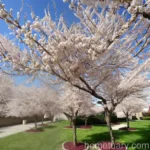Chickasaw Plum (Prunus angustifolia)
In this comprehensive guide, we will delve into the world of Chickasaw plum, scientifically known as Prunus angustifolia. We will explore various aspects including its characteristics, cultivation, uses, care, and ecological importance. Native to North America, the Chickasaw plum has gained popularity not only for its delicious fruits but also for its ecological and cultural significance.
What is Prunus angustifolia?
Prunus angustifolia, commonly known as the Chickasaw plum, is a species of deciduous shrub or small tree in the rose family, Rosaceae. It is native to the southeastern United States, particularly in the region formerly inhabited by the Chickasaw Native American tribe, from which it derives its common name. This plant is known for its excellent adaptability to a wide range of environmental conditions and its eco-functional significance in various habitats.
Key Takeaways – Chickasaw Plum (Prunus angustifolia)
Before we delve into the specifics of cultivation and care, let’s take a quick look at some key takeaways about the Chickasaw plum:
- Prunus angustifolia:
- Scientific name for Chickasaw plum.
- Chickasaw plum varieties:
- The species may have different varieties with varying characteristics and adaptability.
- Native plums:
- Chickasaw plum is a native species, contributing to the diversity and ecological balance of its natural habitats.
- Chickasaw plum characteristics:
- Understanding the features and growth habits of this species is essential for successful cultivation.
- Prunus angustifolia cultivation:
- Exploring the optimal practices for growing Chickasaw plum.
- Chickasaw plum uses:
- The diverse applications of this species, from culinary to ecological.
- Growing Chickasaw plums:
- Understanding the requirements and methods for promoting healthy growth.
- Prunus angustifolia benefits:
- The advantages and positive impacts associated with cultivating this species.
- Chickasaw plum tree care:
- Providing the necessary care and maintenance for mature plants.
- Native fruit trees:
- The ecological and cultural significance of native fruit-bearing trees.
Culture
The Chickasaw plum holds cultural significance, especially for the Native American tribes of the southeastern United States. Historically, the fruits of the Chickasaw plum were consumed fresh or processed into jams, jellies, and beverages. Additionally, various parts of the plant were used for medicinal and ceremonial purposes.
Uses
The uses of Chickasaw plum extend beyond its cultural importance. The fruits are recognized for their exceptional flavor and are utilized in several culinary applications. They can be used to prepare preserves, pies, and even beverages. Furthermore, the plants themselves contribute to landscape and ecological restoration projects due to their adaptability and ability to support local wildlife.
Water
Chickasaw plum plants show good tolerance to drought conditions, making them suitable for cultivation in areas with limited water availability. However, regular watering, especially during the establishment phase, is essential to promote healthy growth and fruit production.
Sunlight
Adequate sunlight is vital for the growth and fruiting of Chickasaw plum plants. They thrive in full sun conditions, meaning they require a minimum of 6 hours of direct sunlight per day for optimal development.
Fertilizer
When it comes to fertilization, the nutritional requirements of Chickasaw plum plants can vary depending on the soil quality and overall growth status. A balanced fertilizer with an N-P-K ratio of 10-10-10 or similar can be applied during the early spring to support healthy growth and fruit production.
Soil
Chickasaw plum plants are adaptable to a wide range of soil types, but they prefer well-drained, slightly acidic soils. Prior to planting, it is recommended to conduct a soil test to determine the nutrient levels and pH, ensuring the soil is conducive to healthy plant growth.
Pruning
Proper pruning is essential for maintaining the shape, health, and productivity of Chickasaw plum plants. Pruning should be conducted during the dormant season to remove dead or diseased wood, improve air circulation, and shape the plant as desired. Additionally, pruning can stimulate new growth, leading to increased fruit production.
Propagation
Chickasaw plum plants can be propagated through various methods, including seed propagation, softwood cuttings, and grafting. Each method has its own requirements and best practices, and the choice of propagation method may depend on the specific objectives and resources available to the grower.
Container Popularity
The adaptability and ornamental value of Chickasaw plum plants make them a popular choice for container gardening. When grown in containers, they can be positioned on patios, balconies, or any suitable outdoor space, adding a touch of natural beauty and the potential for homegrown fruit.
Container Common Diseases
When Chickasaw plum plants are grown in containers, they may be susceptible to certain diseases commonly associated with container gardening. Proper soil drainage, adequate ventilation, and appropriate watering practices can help prevent common container gardening diseases such as root rot and fungal infections.
Disease Diagnosis
Diagnosing and addressing plant diseases is crucial for maintaining the health and vitality of Chickasaw plum plants. Common indicators of diseases include wilted or discolored leaves, stunted growth, and abnormal fruit development. Timely identification and appropriate intervention can help mitigate the impact of diseases on plant health.
Common Pests
Chickasaw plum plants can be affected by various pests, including aphids, caterpillars, and scale insects. Monitoring the plants regularly for signs of pest infestation and implementing suitable pest control measures can help protect the plants from detrimental pest damage.
Botanist’s Tips
To ensure successful cultivation and maintenance of Chickasaw plum plants, consider the following botanist’s tips:
- Regular monitoring and timely intervention are critical for addressing any issues related to plant health, including diseases and pest infestations.
- Proper soil preparation before planting, including amending the soil as needed, contributes to the long-term health and vigor of the plants.
- Consider incorporating Chickasaw plum plants into ecological restoration projects to support native wildlife and enhance biodiversity.
Fun Facts
As we further explore the world of Chickasaw plum, here are some intriguing and lesser-known facts about this native species:
- Chickasaw plum plants are utilized as wildlife habitat, providing food and shelter for various animal species.
- The fruits of Chickasaw plum can vary in flavor and color, with some offerings being particularly sweet and juicy.
- This species has a rich cultural history, with traditional uses by Native American tribes and a legacy deeply rooted in the southeastern United States.
Links to External Resources
For additional information about Chickasaw plum and related topics, the following external resources may be beneficial:
- USDA Plants Database
- Native Plant Conservation Initiative
- National Sustainable Agriculture Information Service
- North American Fruit Explorers
By providing a comprehensive overview of the Chickasaw plum, we hope to inspire individuals to appreciate and explore the cultural, ecological, and culinary significance of this native plant. Whether in home gardens, landscape restoration projects, or permaculture initiatives, the Chickasaw plum stands as a symbol of resilience and interconnectedness within its natural habitats.















